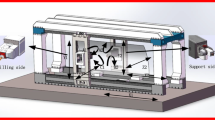Abstract
Driving an object along one axis with two driving systems is a common method for obtaining high acceleration and high trust force for a large CNC machine tool. However, if large synchronous movement error exists between the two driving systems, the machine will not be able to achieve high acceleration. Moreover, it may also cause serious structure deformation and damage to the machine. To solve this problem, a new control method integrating the model reference adaptive control and variable structure control was developed and verified in this study. The proposed method can determine and compensate on-line the synchronous movement errors between two driving systems so that the master driving unit and the slave driving unit of a dual-driving system can synchronously move with no large drag force and reach the desired acceleration. Experiments were performed on a gantry-type two-axis platform with a sliding 5-Kg metal block attached on the X-axis. The experimental results showed that the maximum and the average synchronous movement errors were reduced from 0.061 mm to 0.040 mm and from 0.032 mm to 0.013 mm, respectively.
Similar content being viewed by others
Abbreviations
- D:
-
desired moving displacement of the system
- Ds :
-
current moving displacement of the system
- Vs :
-
moving velocity of the system
- Cs :
-
damper of the slave system
- Ms :
-
mass of the slave system
- F0 :
-
stopping force at e c
- ec :
-
rated control voltage
- V 0 :
-
velocity at the rated voltage
- F 1 :
-
thrust force acting on the system
- C 2 :
-
coefficient of x 2
- τ l :
-
torque of the platform
References
Jee, S. and Lee, J., “Real-time inertia compensation for multi-axis CNC machine tools,” Int. J. Precis. Eng. Manuf., Vol. 13, No. 9, pp. 1655–1659, 2012.
Truong, D. Q., Thanh, T. Q., and Ahn, K. K., “Development of a novel Linear magnetic actuator with trajectory control based on an online tuning fuzzy PID controller,” Int. J. Precis. Eng. Manuf., Vol. 13, No. 8, pp. 1403–1411, 2012.
Lorenz, R. D. and Schmidt, P. B., “Synchronized motion control for process automation,” Proc. of IEEE Conference on Industry Applications Society Annual Meeting, pp. 1693–1698, 1989.
Wong, F. Y., Schulze-Lauen, H., and Youcef-Toumi, K., “Modelling and digital servo control of a two-axis linear motor,” Proc. of the Americal Control Conference, Vol. 5, pp. 3659–3663, 1995.
Omatu, S., Fujinaka, T., and Yoshioka, M., “Neuro-PID control for inverted single and double pendulums,” Proc. of IEEE International Conference on Systems, Man and Cybernetics, Vol. 4, pp. 2685–2690, 2000.
Saaj, C. M. and Bandyopadhyay, B., “Variable structure model following controller using non-dynamic multirate output feedback,” International Journal of Control, Vol. 76, No. 13, pp. 1263–1271, 2003.
Sun, D., Dong, H. N., and Tso, S. K., “Tracking stabilization of differential mobile robots using adaptive synchronized control,” Proc. of IEEE International Conference on Robotics and Automation, Vol. 3, pp. 2638–2643, 2002.
Lu, Z., Shieh, L. S., and Chandra, J., “Tracking control of nonlinear systems: A sliding mode design via chaotic optimization,” International Journal of Bifurcation and Chaos, Vol. 14, No. 4, pp. 1343–1355, 2004.
Byun, J. H. and Choi, M. S., “A method of synchronous control system for dual parallel motion stages,” Int. J. Precis. Eng. Manuf., Vol. 13, No. 6, pp. 883–889, 2012.
Kang’ethe, S. M. and Hinga, P. K., “Position control using variable structure control,” IEEE AFRICON 4th, Vol. 1, pp. 251–254, Vol. 251, 1996.
Azenha, A. and Machado, J. A. T., “Stability analysis in variable structure position/force hybrid control of manipulators,” Proc. of INES’ 97 IEEE International Conference on Robotics and Automation, pp. 327–332, 1997.
Lai, C. L. and Tsai, C. C., “Modeling and velocity control of a singlesided linear induction motor,” Proceeding of R. O. C. Automatic Control Conference, pp. 577–584, 1998.
Yajima, H., Wakiwaka, H., Senoh, S., Minegishi, K., Fujiwara, N., and Tamura, K., “Consideration on high-response of a linear DC motor,” IEEE Transactions on Magnetics, Vol. 33, No. 5, pp. 3880–3882, 1997.
Yu, X. and Potts, R. B., “A class of discrete variable structure systems,” Proc. of the 30th IEEE Conference on Decision and Control, pp. 1367–1372, 1991.
Dana, R. and Kreindler, E., “Variable structure control of a tank gun,” Proc. of IEEE Conference on Control Applications, pp. 928–933, 1992.
Author information
Authors and Affiliations
Corresponding author
Rights and permissions
About this article
Cite this article
Wang, SM., Wang, RJ. & Tsooj, S. A new synchronous error control method for CNC machine tools with dual-driving systems. Int. J. Precis. Eng. Manuf. 14, 1415–1419 (2013). https://doi.org/10.1007/s12541-013-0191-y
Received:
Accepted:
Published:
Issue Date:
DOI: https://doi.org/10.1007/s12541-013-0191-y




